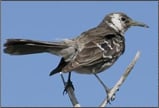Floreana Mockingbirds closer to reintroduction
Originally published on November 5th, 2010

It's a little known fact, but when Charles Darwin visited the Galapagos Islands in 1835, he wasn't very interested in the finches at all! Instead, he was initially fascinated by the different Galapagos mockingbirds, each of which is slightly different. Of particular interest was the Floreana variety of the Galapagos mockingbird, as he was on the island for a while and had the chance to study its behavior in the wild. It wasn't until much later, back in England, that Darwin began to examine the Galapagos finches and decided to use them to help illustrate his theories.
Darwin wouldn't recognize Floreana today. The landscape is covered in unfamiliar plants including blackberries, quinine trees and elephant grass. The giant tortoises, once so common on Floreana that Darwin claimed that one ship alone was able to capture 200 in a day, are extinct. But maybe he would miss the mockingbirds most of all. They have been extinct on Floreana itself for decades, victims of introduced species. Now they only survive on two islets (Champion and Gardner) off the coast of Floreana, and experts estimate there are only 500 or so of them in total.
Project Floreana
But help is on the way. Floreana was the first island to be colonized by man, and as such is arguably the most contaminated of all of the Galapagos Islands. A five year project known as Project Floreana is in full swing, and its aim is to get rid of invasive species and return the Floreana Mockingbird to its home. The ambitious project is funded by an impressive array of supporters, including the Prince Albert II of Monaco Foundation, the Galapagos Conservation Trust, the Lindblad/National Geographic Fund, the St. Louis Zoo, the University of Missouri and many more.
The Avian Health Survey
One of the key steps in this process is to examine the state of health of birds (endemic and introduced) on Floreana. Recently (September 2010), results of an initial survey were released. There are some worrisome diseases and parasites infecting the Floreana birds, including the Philornis Downsi fly, which lays its eggs in bird nests, leaving its larvae to attack hatchlings: this nasty parasite was unknown in the Galapagos until 1997. Also, some of the domestic chickens raised on Floreana have Newcastle's Disease, which can also affect wild birds. Eradication or control of these pests and diseases will be key to the reintroduction of the Floreana Mockingbird.
Diverse Genetics
A diverse genetic base is also important if the population is to survive. Since the Gardner and Champion mockingbird populations do not mix, researchers were able to study their genes and even compare them with Darwin's original specimens. Results show a strong link between Darwin's birds and the ones on Champion and Gardner: an encouraging sign.
Good News
The best news is the population levels of the birds on both islands. In 2006 there were only about 20 mockingbirds left on Champion: now there are 55. The Gardner population is up from 120 in 2006 to around 500 or so today. These numbers are very encouraging and bode well for an eventual reintroduction to Floreana itself.
Those in charge of Project Floreana hope the day of the mockingbird's return is not far off. Darwin would be proud!

